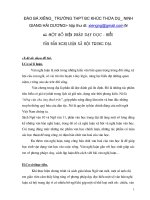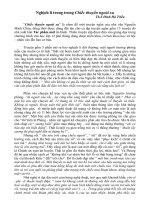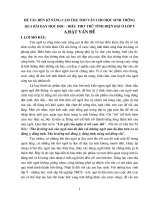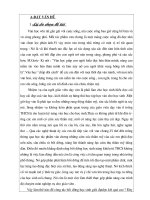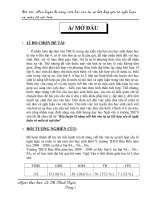Sang kien kinh nghiem Anh van
Bạn đang xem bản rút gọn của tài liệu. Xem và tải ngay bản đầy đủ của tài liệu tại đây (79.05 KB, 13 trang )
Table of contents.
A. Introduction.
B. English Animal-based comparison idioms
I. General view of English idoms.
1. Definition of English idoms.
2. Characteristics of English idoms.
II. Animal-based comparison idoms in English.
1. Classification of comparison idoms in English.
2. Meaning of animal-based comparison idoms in English.
C. Conclusion.
Part A: Introduction
English is an international language and is widely used all over the world.
1
Almost all books can now be written in English. In high schools in Vietnam, English
is also a compulsory subject. It helps students widen their knowledge not only in
studying other subjects at school but also in every other fields of life.
In high school now, students focus on learning English grammar which can
help them in their examinations. In English grammar, there are some basic parts
which must be acquired before learning other parts like verb tenses, passive voice
and comparison is one of these parts.
Learning English especially English grammar is rather boring for Vietnamese
students. So it is necessary to find out as many ways as possible to make an English
lesson more interesting. When I am teaching comparison, I took an animal-based
comparison idiom as an example and saw that students are very interested in this
kind of comparison. They asked me for other examples. I see that it is a good idea to
give them a list of animal-based comparison idioms. It not only helps them learn
English grammar on comparison but helps them find English grammar more
interesting as well. That is why I choose to write about English animal-based
comparison idioms in this study. I hope this study can be applied widely in high
schools in Vietnam.
Part B: English Animal-based
comparison idioms
I. General view of English idioms
1. Definition of English idioms
All languages have phrases and sentences that cannot be understood literally.
Even if you know the meanings of all the words in a phrase and understand the
grammar of it completely, the meaning may be confusing. A phrase of this type is
said to be idiomatic, or in other words, they are idioms.
So “what is an idiom?” The question has many answers.
2
According to Dictionary of English idioms 1976: “An idiom is a fixed group
of words with a special different meaning from the meanings of several words”. For
instance, “let the cat out of the bag” means to reveal a secret carelessly or by
mistake.
The Longman Dictionary of Language Teaching and Applied Linguistics
defines idioms as expressions which function as single units and whose meanings
cannot be worked out from their separate parts.
In Oxford English Dictionary, idiom is defined as a peculiarity of phraseology
approved by the usage of language and often having a signification other than its
grammatical or logical one.
Seidle and Mordie, in their English Idioms also define: “Idioms as a number
of words taken together, mean something different from the individual words of the
idioms when they stand alone”.
As can be seen from the above definitions, idioms have been defined variously
but all of them share the same view on the matter. Most linguists agree that idioms
are phrases where the whole phrase means something different from the meanings of
several words.
2. Characteristics of English idioms
a. Semantic characteristic
Most of the idioms are metaphorical than literal. Therefore, one cannot usually
discover their meanings by looking up the meaning of individual words in a
dictionary. Their meanings must be understood metaphorically. A number of
linguists have distinguished the meaning of idioms from the meaning of other kinds
of expressions.
According to A.V.Kunin, the meaning of an idiom is either partly or
completely different from the meanings of all components. The partly different ones
such as “cat and dog life” and their meaning can be guessed while the totally
different ones like “to let the cat out of the bag” cannot be guessed. All these idioms
3
are embodied with metaphorical expressions and they must be understood
metaphorically.
Idioms are also said to have positive meaning, negative meaning and neutral
meaning. Some idioms like “a lucky dog” (a very lucky person); “dressed like a
dog’s dinner” (a very well-dressed person) have positive meaning. Some idioms
convey negative meaning such as “a dog’s breakfast” (a mess, a thing done badly).
“Let the sleeping dog lie” is an idiom of neutral meaning. We use it when we mean
“don’t mention the things that happened in the past”.
b. Figurative characteristics
Most of, if not all English idioms share this characteristic. Idioms always
contain images, which result from metaphor, in themselves. These hidden images can
be either easy or difficult for readers to imagine. It is the figurativeness of idioms
that makes the expressions more lively and impressive.
c. Structural characteristic
Idioms are word-groups with constant structure. One cannot change their word
order apart from accepted variants. He can neither omit or add any component to
fixed structure of idioms. Idioms can be very different at length from each other. In
other words, the number of words in each idiom can vary from one to many. For
example, one-word idiom like “fishy” (doubtful) and “when the cat’s away, the mice
will play”. Idioms can have a regular structure, an irregular or even grammatically
incorrect structure. For example, one may say “I am good friends with him” even
though it is illogical in grammatical structure.
In short, idioms are fairly free in their grammatical structures.
4
II. Animal-based comparison idioms in English
1. Classification of comparison idioms in English
In fact, there exists three types of comparison named: equal comparison,
superior comparison and superlative comparison, but in a small study like that only
equal comparison is focused on. In English, equal comparison idioms are classified
into three kinds:
- Comparison with adjectives
- Comparison with verbs
- Miscellaneous comparison
Most comparison are used with adjectives and follow the pattern:
For example:
“As cool as a cucumber”
“As cunning as a fox”
“As green as grass”
“As silent as the dead”
In addition, there are many other idioms of comparison which are under
pattern:
As the following list:
As + adjective + as + (a/the) + noun
5
Verb + like + (a/the) + noun

